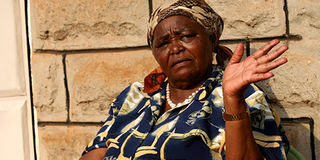Mzee’s death changed lifestyle in Gatundu

STEPHEN MUDIARI | NATION
Veronica Waceke Nyanjui speaks during interview in Gicheha village in Gatundu on Sunday.
In the afternoon of August 22, 1978, residents of Gicheha village in Gatundu were going on with their lives as they had done through the ages.
That particular afternoon, they had an important matter to attend to. Some of them had congregated in the home of a neighbour who had died to make funeral arrangements.
Unknown to them, another neighbour had died, hundreds of miles away in Mombasa. But this other neighbour was no ordinary man. He was President Jomo Kenyatta.
In their minds, Mzee Kenyatta was immortal. He couldn’t just die. So when the news of his death came through the radio, the villagers were stunned.
“Nobody would have imagined his death. When we learnt of his death, everybody forgot about the funeral we were planning. Everybody hurried to their homes,” recalls Veronica Waceke Nyanjui.
Now in her late 70s, Mrs Nyanjui is one the few surviving neighbours who lived next the late President since his release from prison in 1961.
Her home faces the back entrance of Mzee Kenyatta’s Gatundu home. Beyond her home and down the valley, Mzee Kenyatta had a farm where he grew pineapples.
He loved walking to the farm when he was home. “He would walk by my house and talk to me across the barbed fence. He also used to admire my cows and would ask me what I had been feeding them on."
After his release and before he became President, Mzee Kenyatta was a regular figure in Gicheha village.
“He loved swimming and he would regularly pass through accompanied by Mbiyu Koinange on their way to Thiririka river. In the river, there was a deep section where they would swim for hours,” recalls Mrs Nyanyui.
Ever since he was released, Mzee Kenyatta’s Gatundu home was always a hive of activity with delegations from around the country coming to see him.
“The day Mzee returned from prison was memorable. People had travelled in buses and lorries from all over the country to welcome him home. There was hardly any standing space in and around his compound,” says Mrs Nyanyui.
From that point to the day he died, Mzee Kenyatta’s home remained a boisterous place because he continued receiving groups of people any time he was home. He used to commute from Gatundu to Nairobi every day. His other favourite places were Nakuru and Mombasa.
“There were many visitors all the time. In fact, some of the more enterprising people made a living making tea and for sale to the visitors.”
In addition to the delegations, the late President enjoyed watching traditional dancers and would spend entire afternoons listening to them.
All this changed the day Mzee Kenyatta died. Silence and uncertainty engulfed the village.
Patrick Ngure, who was 24 years old when Mzee Kenyatta died, recalls that day. He had gone to visit his grandmother at Riuki village, Ruiru.
“When we heard Mzee had died, I decided to rush back home. I remember everybody I met was also hurrying home. I have never experience such communal fear and anxiety,” says Mr Ngure.
Such was Mzee Kenyatta’s omnipresence among his neighbours that his departure threw them off balance.




